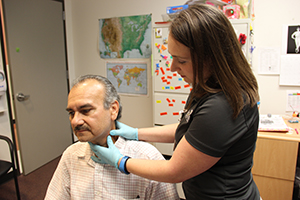Lymphedema is a very common diagnosis after lifesaving head and neck cancer treatments, and it profoundly affects patients’ quality of life. Among those who have developed lymphedema is Elías Torres, who benefited from the teamwork between TIRR Memorial Hermann Outpatient Rehabilitation and the division of Head and Neck Surgical Oncology at Memorial Hermann-Texas Medical Center. The interdisciplinary collaboration brings together surgical oncologists and rehabilitation professionals focused on improving life for survivors before, during and after cancer treatment.

Based on the office exam, Torres’ family practitioner at UT Physicians referred him to Jorge Quesada, MD, an associate professor in the division of Oncology at McGovern Medical School at UTHealth. When a biopsy revealed squamous cell carcinoma on the left tonsil, Dr. Quesada referred his patient to Ron J. Karni, MD, chief of the division of Head and Neck Surgical Oncology and an associate professor with dual appointments in the department of Otorhinolaryngology-Head and Neck Surgery and the division of Medical Oncology at McGovern Medical School.
Torres underwent chemotherapy and radiation, followed by surgery to remove residual enlarged lymph nodes. “The surgery went very well, and today you can hardly see my scar,” he says. “Dr. Karni is awesome – a very nice guy who’s straightforward and informative. He really took the time to answer all the questions my wife and I had.”
TIRR Memorial Hermann offers therapy services specific to head and neck cancer in a hub-and-spoke model, working synergistically with the department of Otorhinolaryngology-Head and Neck Surgery in the Texas Medical Center. Before surgery, Susy Stanley, OTR, CLT, an occupational therapist certified in lymphedema therapy, saw Torres for prehabilitation at Memorial Hermann Outpatient Rehabilitation-Kirby Glen. “We spend a lot of time educating patients about how to prepare for chemotherapy, radiation and surgery,” Stanley says. “We also teach simple strategies for energy conservation because fatigue is a significant problem during and after chemotherapy.”
Stanley worked with Torres on increasing flexibility in his neck, shoulder, scapula and trunk. “We want all these areas to be extremely loose going into the treatment,” she says. “We also focused on lymphedema management. Prehabilitation is unique for each patient, but the gold standard for management of lymphedema involves four activities: exercise, meticulous skin care to avoid infection, manual lymph drainage and compression. These four things work together to control swelling after treatment.”
Torres continued to work with Stanley following his surgery and also saw speech language pathologist Rachel Zuckman, CCC-SLP, to improve his ability to swallow. “Eli was having difficulty moving the entire structure involved in swallowing,” Zuckman says. “We practiced different types of swallowing exercises focused on the base of the tongue, throat musculature and coordination of movement in the structure. We also worked on massage to the scar bands on his neck to increase blood flow and help improve movement as well. After working on improving his sense of taste and tolerance for different types of tastes, we saw improvement in his ability to take more food and different types of food. We improved his eating endurance so that he could get through more of a meal in order to maintain his weight. He also switched to eating five or six small meals a day, instead of three larger meals.”
Both Stanley and Zuckman say Torres worked hard in therapy. “It was such a privilege to work with him,” Stanley says. “Patients who are as invested in therapy as Eli was are very special to us. He took his home program to heart and because of this, he made great gains. We were all very proud of him.”
The collaboration between rehabilitation and head and neck surgical oncology came about when providers from both disciplines recognized that a significant piece of the continuum of care was missing in the experience of head and neck cancer patients. “We’ve become much more efficient at curing cancer, which has increased the importance of improving quality of life in survivorship,” Dr. Karni says. “The worse part of a cancer diagnosis is fear of the unknown. Patients want the peace of mind that comes with knowing that we can help them with all their needs related to cancer treatment. Working with TIRR Memorial Hermann was immediately attractive to us because of their expertise in physical therapy, occupational therapy, speech therapy and lymphedema management, and the distribution of their outpatient programs throughout the city. In addition to seeing a surgeon, medical oncologist and radiation oncologist, our head and neck cancer patients now also see therapists who help with issues that affect quality of life.”
Torres is frank about the changes in his life. “I’m a macho guy and like to eat barbecue and drink beer. I don’t do that anymore, but I also look at the other side of it. I’ve improved thanks to the work of my great therapists. I have a good healthy lifestyle, and I am cancer free. I’m taking all that and moving forward.”